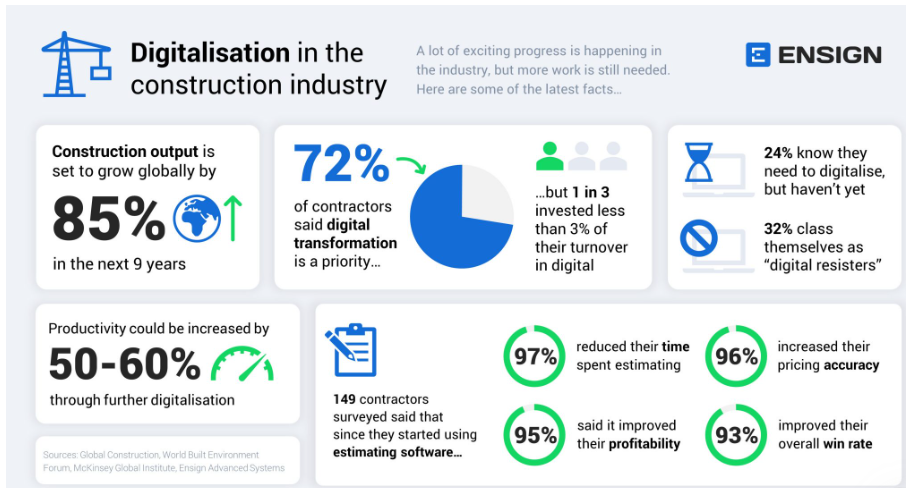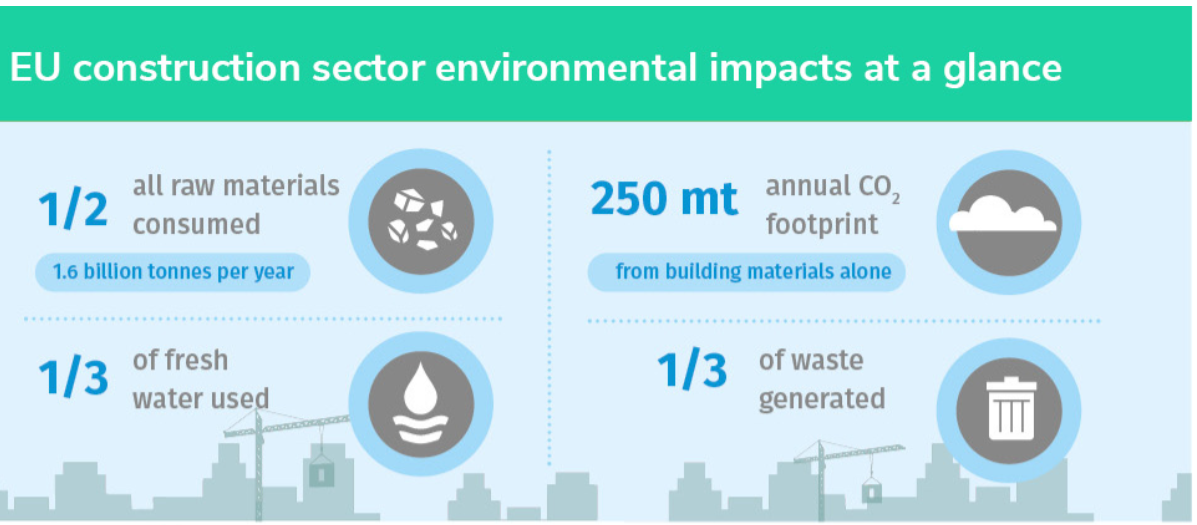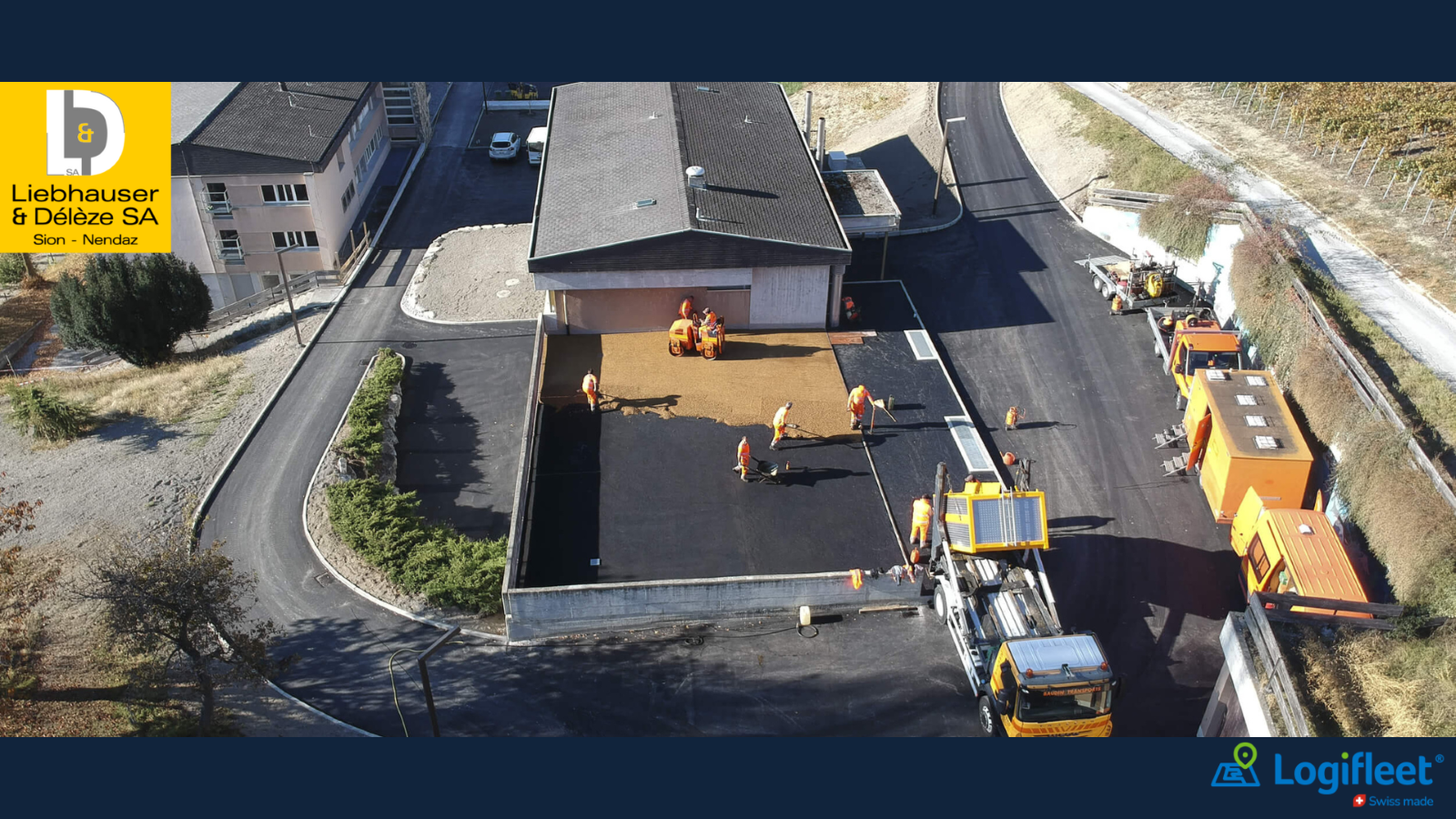- Home
- Logifleet Blog
- Digitalisation in Construction: The Rise of Digital Management
Digitalisation in Construction: The Rise of Digital Management

In construction, efficiency, reliability, and precision decide project success. Mastering heavy machinery is not a choice but a necessity. As industry veterans, we know that managing these behemoths of machinery is not an easy feat. The old method has many problems. It is often wrong, slow, and expensive.
In this article, we will explore the management change in the construction industry. How Logifleet strives to make things better and set new standards for excellence.
The Need for Digitalisation in Heavy Machinery Management

Source: https://ensignonline.co.uk/digitalisation-in-the-construction-industry/
In construction, heavy machinery is the backbone of productivity. Big excavators are necessary for projects to succeed. Managing these assets presents many challenges. These challenges can impact the efficiency, cost-effectiveness, and safety of construction operations.
We pack them into 3 main categories:
- Tracking and Visibility Challenges (1 out of 4 workers is occupied with unnecessary travel)
- Operational Efficiency and Cost Management Challenges (1 out of 5 workers is busy with unnecessary tasks that require filling out paper forms)
- Environmental Challenges (1 out of 5 machines is not utilized)
Tracking and Visibility Challenges
Issue of Asset location
On construction sites, tracking the location of each piece of equipment is hard. Traditional methods rely on manual checks and word-of-mouth updates. These methods are slow and prone to errors.
Usage and Deployment
To distribute assets, it is crucial to understand:
- which equipment is being used
- when it is being used
- for how long is being used
Companies without digital tools struggle to understand how to use their equipment effectively. This can lead to using their assets too much or not enough.
Reactive vs Proactive Maintenance
Traditional maintenance approaches are often reactive. Repairs are made after breakdowns occur. This not only leads to unexpected downtimes. It also increases repair costs and extends project timelines.
Record Keeping and Scheduling
Keeping track of an updating manual maintenance logs and schedules is difficult. This increases the risk of missed maintenance activities. Missed maintenance activities can cause equipment failure and create safety hazards on site.
Operational Efficiency and Cost Management Challenges
Inefficient Resource Allocation
Without a clear view project managers find it challenging to distribute resources. This inefficiency can result in project delays and increased costs.
Cost Control
Heavy machinery involves significant financial investment, operation, and maintenance. Without a comprehensive digital management system, controlling these costs is difficult. Optimizing ROI becomes almost impossible.
Negative Impact on The Environment

Source: https://ecostandard.org/news_events/its-time-to-green-the-construction-sector/
The construction industry is a major contributor to greenhouse gas emissions. It is also responsible for other environmental challenges. It produces over one-third of global carbon emissions. It uses one-third of global resources and consumes 40% of worldwide energy. These statistics paint a scary picture of the industry’s environmental footprint.
The Next Chapter in Heavy Machinery Management

Source: McKinsey survey of 400 construction-industry CxOs; expert interviews; McKinsey analysis
IoT (Internet of Things)
Imagine that your heavy machinery can send updates to your phone. These updates tell you where the machinery is and how it is working. It is like sending a text message. This helps you know what’s happening with your equipment right away. It makes it easier to manage projects and keep track of machinery. You can even prevent theft by knowing where everything is all the time.
GPS tracking
GPS in construction is like using a map on your phone to find a friend in a crowded place. Imagine you have a bunch of trucks and machines working on a big construction site.
With GPS tracking, you can see on your computer or phone exactly where each piece of equipment is. As like spotting your friend’s location on your map app. This helps you make sure machines are where they need to be and can also help keep them safe from stealing.
Automated Maintenance Scheduling
Combined with data analytics this becomes like a smart health app for machines. Like a fitness tracker that predicts when you might get sick based on your activity. Machines send data about how they are working.
This smart system can predict when a machine will need repairs before it breaks down. This means less waiting time for repairs and longer-lasting machines. It saves money, like how staying healthy reduces trips to the doctor.
Data Analytics for Operational Insights
Data analytics is like a coach for a sports team studying past games to create strategies. For example. If certain equipment is often not used, a construction manager can change their plan. The same applies to machines used too much.
The manager can choose when and which machines to use for peak performance. This helps the project team work together better, be more efficient, and save money.
For example, automatic machine reports can bring data directly to your ERP to make your life easier on the construction site.
Digital Platforms for Collaboration
Digital Collaboration Platforms are online meeting spaces. Project members can communicate, share files, and work together, regardless of their location. This fosters collaboration, streamlines planning, and enhances project efficiency.
Cloud-based Management Systems
This is like having a digital toolbox that you can open from anywhere, whether you are at the office or on-site. You can use these systems to:
- track your equipment
- schedule repairs
- check how well everything is working
You can do this all from a computer or smartphone.
The systems can grow with your project. From a few pieces of equipment to hundreds. Making sure you have the right tools at hand no matter the job size.
Putting everything into practice

Liebhauser & Délèze SA, a Swiss construction company, operates in a variety of business areas.
- buildings
- public works
- civil engineering
- water catchments & development
- sanitation works
- renovations, and protection against natural hazards
Before implementing Logifleet's solutions, the company faced challenges in efficiently locating and managing its fleet of 20 vans, 21 machines, and 100 tools, leading to significant annual expenses and inefficiencies.
Julien Délèze, Director of Liebhauser & Délèze SA, describes the transformative impact of Logifleet's solutions on their operations:
"Before, our operators lost precious time locating devices and machines. We were constantly searching for small devices. The system was analog, not centralized, and heavily dependent on the people managing it. Now, gone are the days of wasted time and additional costs. The warehouse worker does not have to spend hours solving inventory issues."
Through the adoption of Logifleet's advanced tracking and management technologies, Liebhauser & Délèze SA has realized significant annual savings exceeding CHF 114,000.
These savings are attributed to the:
- elimination of equipment rental
- replacement costs
- reduction in time spent searching for equipment
- and streamlining administrative processes for billing information collection.
50 to 75% time savings for administrative staff, depot managers, and workers.
120 hours saved, 60 hours, 45 hours.
Logifleet's solutions have enabled Liebhauser & Délèze SA to automate and digitize their operations, leading to improved efficiency, cost savings, and enhanced operational transparency.
In summary
You might be asking, how can I apply these technologies to my specific projects, and how exactly do they help?
The answer lies in predictive maintenance.
Rather than reacting to issues as they arise, we use data to predict and prevent problems well in advance.
Predictive maintenance uses these insights to predict equipment needs. This prevents breakdowns and ensures smooth project progression. This strategy improves operational efficiency and resource usage. It also leads to a future where construction practices are innovative, increase productivity, and save costs.
En Budron H9
CH-1052 Le Mont s / Lausanne
T +41 21 651 06 51
Merkurstrasse 25
CH-8400 Winterthur
T +41 71 277 52 47